New evidence demonstrates Russian soldiers executing people in Bucha
An American newspaper published a detailed investigation into the murders committed by the Russian military during the occupation of Bucha, Kyiv region.
The publication received new recordings from surveillance cameras and eyewitness testimony.
Videos and eyewitness testimony, obtained by The New York Times, provided evidence of Russian troops executing eight Ukrainian men in the Kyiv suburb of Bucha on March 4.
In two of the released videos, Russian paratroopers are featured marching them at gunpoint along a street in Bucha, a suburb of Kyiv. This is the last time these men were seen alive.
Some of the Ukrainian prisoners are hunched over, holding the belts of those in front of them. Others have hands over their heads. “Walk to the right, bitch,” one of the soldiers tells them.
The videos, filmed on March 4 by a security camera and a witness in a nearby house are the clearest evidence to date that the men were held in the custody of the Russian troops minutes before being executed.
“Hostages are lying there, against the fence,” says the person filming one of the videos.
The men are forced to the ground, including one wearing a distinctive bright blue sweatshirt.
The video ends. But eight witnesses attest to what happened next. Soldiers took the men behind a nearby office building, that the Russians had taken over and turned it into a temporary base. There were gunshots. The captives didn’t return.
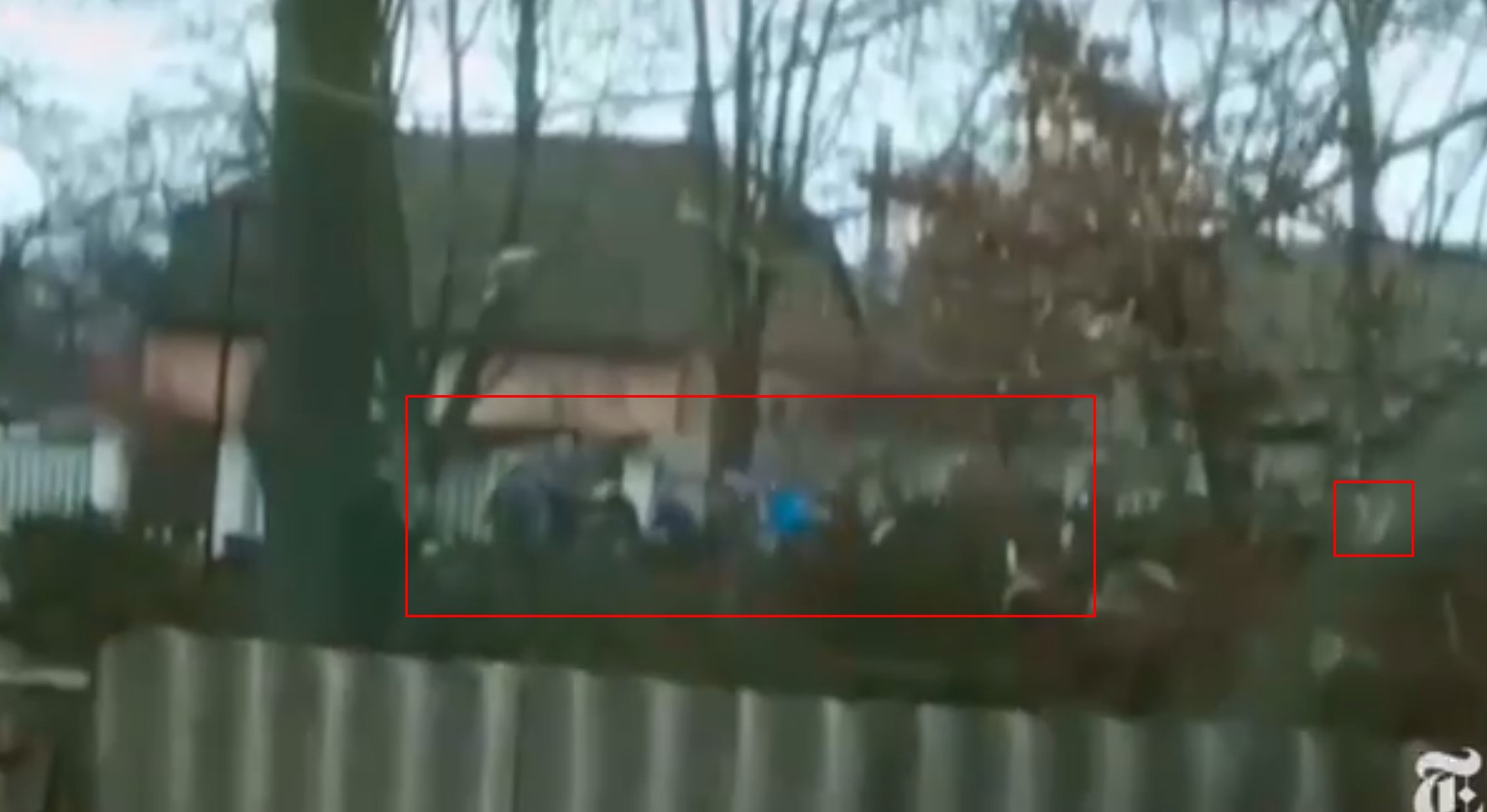
The drone video filmed a day later, on March 5, is the first visual evidence that confirms eyewitness accounts. It records the bodies lying on the ground by the side of the office building at 144 Yablunska Street as two Russian soldiers are standing guard beside them. Among the bodies, a flash of the bright blue was visible – the captive in the blue sweatshirt.
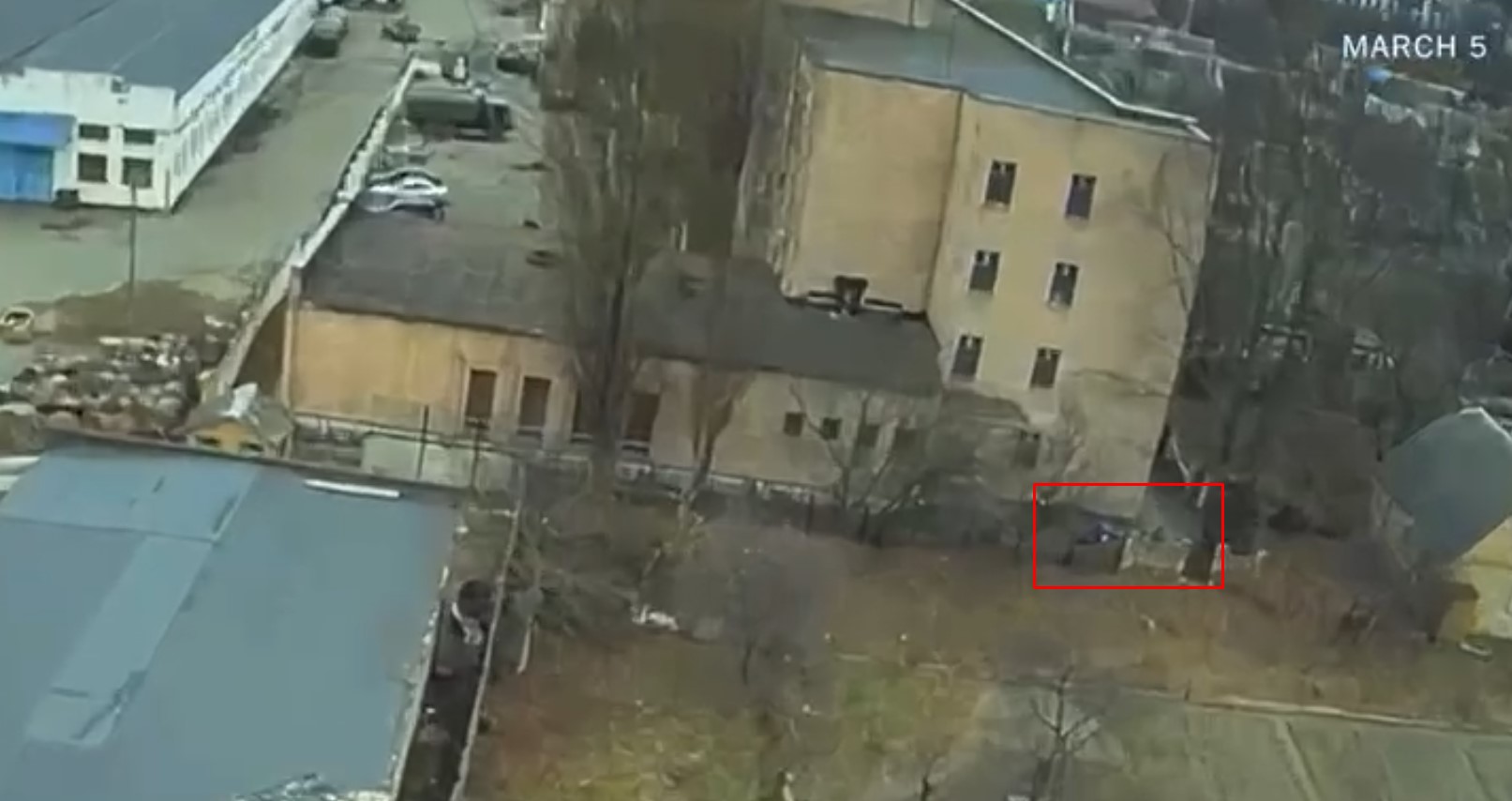
A photograph of the bodies of executed men lying in the courtyard, some with their hands bound, was among a range of photos that received global attention in early April after Russian troops withdrew from Bucha.
Russian leaders at the highest level have repeatedly denied the Bucha crime and called the photos “provocation and fake.”
Yet the investigation provides new evidence, including three videos, that Russian paratroopers rounded up and intentionally executed the men photographed in the courtyard, directly implicating these forces in the war crime. Russia’s foreign affairs and defense ministries did not respond to requests for comment on The New York Times findings.

To uncover what happened to these people, investigators spent several weeks in Bucha interviewing a survivor, witnesses, coroners, police, and the servicemen. Reporters collected previously unpublished videos from the day of the execution – some of the only evidence thus far to trace the final movements of the victims.
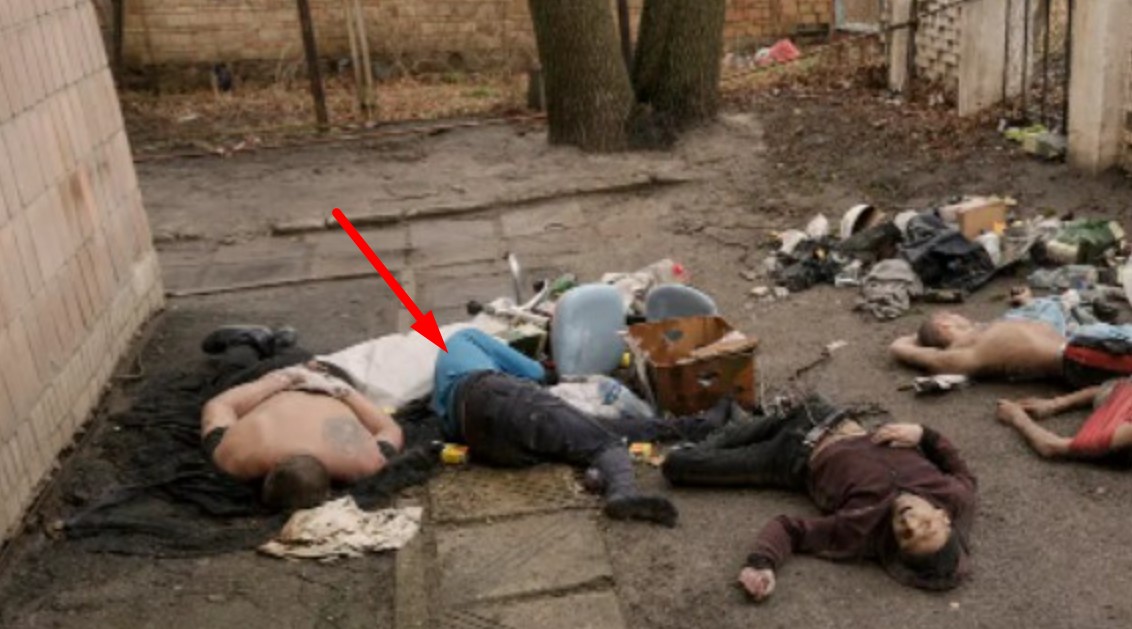
Investigators scoured social media for missing persons reports, spoke to the victims’ family members, and, for the first time, identified the names of all executed men and why most of them were targeted.
They were husbands and fathers, grocery store and factory workers, who lived ordinary civilian lives before the war. But with restrictions on men leaving the country, coupled with a resolve to protect their communities, most of the men joined various defense forces in the days before they were killed. Nearly all of them lived within walking distance of the courtyard in which their bodies would later lie.

Return to Bucha
Russian soldiers first entered Bucha in late February, days after the war began, as they advanced toward Kyiv. Ukrainian forces were ready to meet them. They devastated Russian paratroopers at the front of the column in an ambush. Reports of deaths and interviews with Russian prisoners of war posted by Ukrainian YouTuber indicate that at least two paratrooper units, the 104th (unit 32515) and the 234th (unit 74268) Airborne Assault Regiments, suffered losses.
The Russians withdrew and regrouped before returning on March 3, making their way to Yablunska Street, a long street thoroughfare running through the city. Security camera footage obtained by investigators shows that the soldiers, like those who were ambushed in late February, were paratroopers.
The video shows them driving vehicles such as the BMDs, that are used by the Russian Airborne Forces.
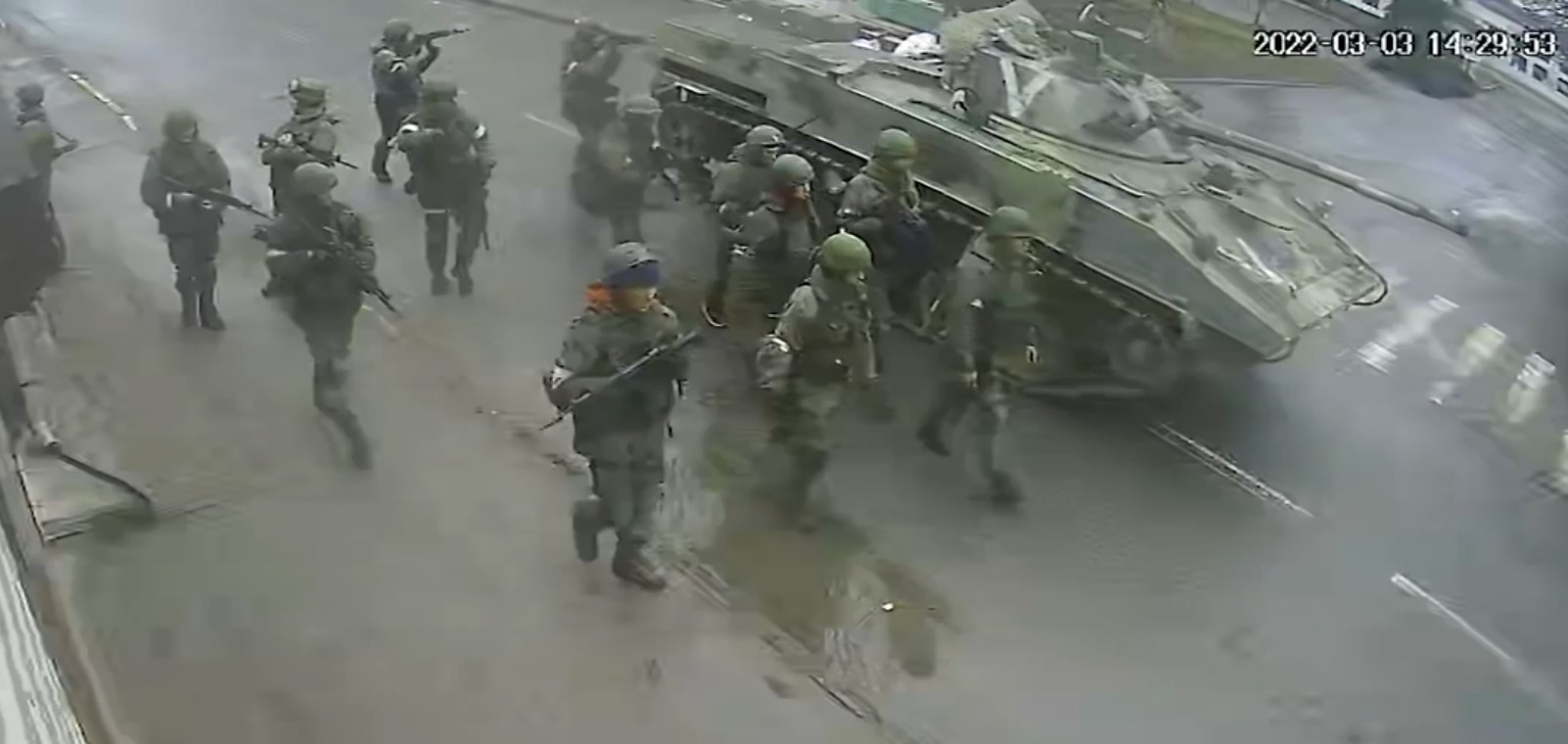
The paratroopers patrolled the area, conducting house-to-house searches and operating in and out of 144 Yablunska Street, a four-story office building that the Russians turned into a base and field hospital.
About 280 meters from that base, at 31 Yablunska Street, Ivan Skyba, a 43-year-old construction worker, and five other Ukrainian fighters had been manning a makeshift checkpoint when the Russians returned. They had a grenade, bulletproof vests, and a rifle between them, Mr. Skyba said.
Warned via the radio that the Russians were back in Bucha and moving in their direction, they hid in a house beside the checkpoint, along with the homeowner, 53-year-old Valeryi Kotenko, who had been bringing tea and coffee to the fighters, Mr. Skyba said.
They were joined later by two more fighters, Andriy Dvornikov and Denys Rudenko, the man in a blue sweatshirt in the video.
As the nine men hid, they texted and called relatives. Mr. Rudenko messaged his best friend saying they were trapped. “Don’t call. I will dial later,” he wrote.
The men sheltered there overnight. By the morning of March 4, they realized that an escape was impossible. “We are surrounded,” Mr. Rudenko wrote to his friend. “For now we are hiding. They are shooting from armored vehicles and heavy caliber.”
Mr. Dvornikov, a delivery driver, called his wife, Yulia Truba, at 10:20 a.m., she said. “We can’t get out. I will call when I call,” he said, before telling her to delete all their messages and prepare to evacuate. “I love you,” he said.
About an hour later, Russian soldiers conducting searches found the men and forced all nine of them, including the homeowner, out of the house at gunpoint, Mr. Skyba said. The soldiers searched the men for tattoos that could indicate military affiliation and made some of them take off their winter jackets and shoes. Then they walked them to the Russian base at 144 Yablunska Street.
What happened next was described by Mr. Skyba and seven civilian witnesses, whom Russian forces also rounded up from neighboring houses and held in a separate group in the yards of captured Ukrainian fighters.

The witnesses said they saw a group of prisoners in the parking lot in front of the Russian base in shirts pulled over their heads. Yura Razhik, 57, who lives in front of the office building, said some had their hands tied. According to Skyba, Russian soldiers forced them to kneel down and then shot one of the men, 28-year-old Vitaly Karpenko, almost immediately. Mr. Skyba said he had also witnessed the shooting.
According to him, Mr. Skyba and another prisoner, Andriy Verbovyi, were taken inside the building, where they were questioned and beaten before Mr. Verbovyi was shot and killed. The soldiers took Mr. Skyba back to the parking lot, where other checkpoint guards were still being held.
At one point, one of the checkpoint guards confessed to the Russians that they were Ukrainian fighters, Mr. Skyba said, and the man was eventually let go. According to the local military commander and investigators, he is now under investigation by Ukrainian authorities; the government document, which the journalists got acquainted with, states that it is a case of treason.
The soldiers debated what to do with the remaining men. “Get rid of them, but not here, so that their bodies aren’t laid around,” one said, according to Mr. Skyba.

A courtyard execution
According to Mr. Skyba, two Russian soldiers took him and other prisoners to a courtyard on the side of the building, where the body of another dead man was already lying. Investigators have identified the man as 37-year-old Andriy Matviychuk, another fighter who went missing a day earlier. According to his death certificate, he was shot in the head.
According to them, Mr. Razhik and other witnesses near saw the soldiers lead the prisoners out of sight to the office building. Then, gunshots rang out.
“I was shot and I fell down. The bullet went into my side,” said Mr. Skyba. The photos of his injuries, which he shared, show an entry and exit wound on the left side of the abdomen. A doctor in Bucha who treated his wound and a medical report reviewed by journalists confirmed the injury.
“I fell down and pretended to be dead,” he said. “I did not move or breathe. It was cold outside, and people’s breath could be seen.”
Mr. Skyba lay there as the soldiers fired another volley at the wounded who were still moving. He waited for about 15 minutes until he could no longer hear the voices of soldiers. Then, he ran.
Tetyana Chmut, whose garden borders the courtyard at 144 Yablunska Street, was among the residents held and later released by the Russians, along with her family. When Ms. Chmut dashed from her house to a nearby basement later on March 4, she saw bodies lying in the courtyard. Ms. Chmut’s neighbor, Maryna Chorna, saw the bodies two days later when she emerged from her basement after Russian troops occupying her house left.
The bodies of the men killed in the parking lot and inside the building were brought to the courtyard and laid there with six other victims for nearly a month.
Evidence of a war crime
Four weeks later, after Russian troops had withdrawn from Bucha, journalists visited the scene of the executions. The wall and steps of the building were pockmarked by bullet holes. On the other side of the courtyard, a few meters from the place where the bodies laid, there were cartridge casings.
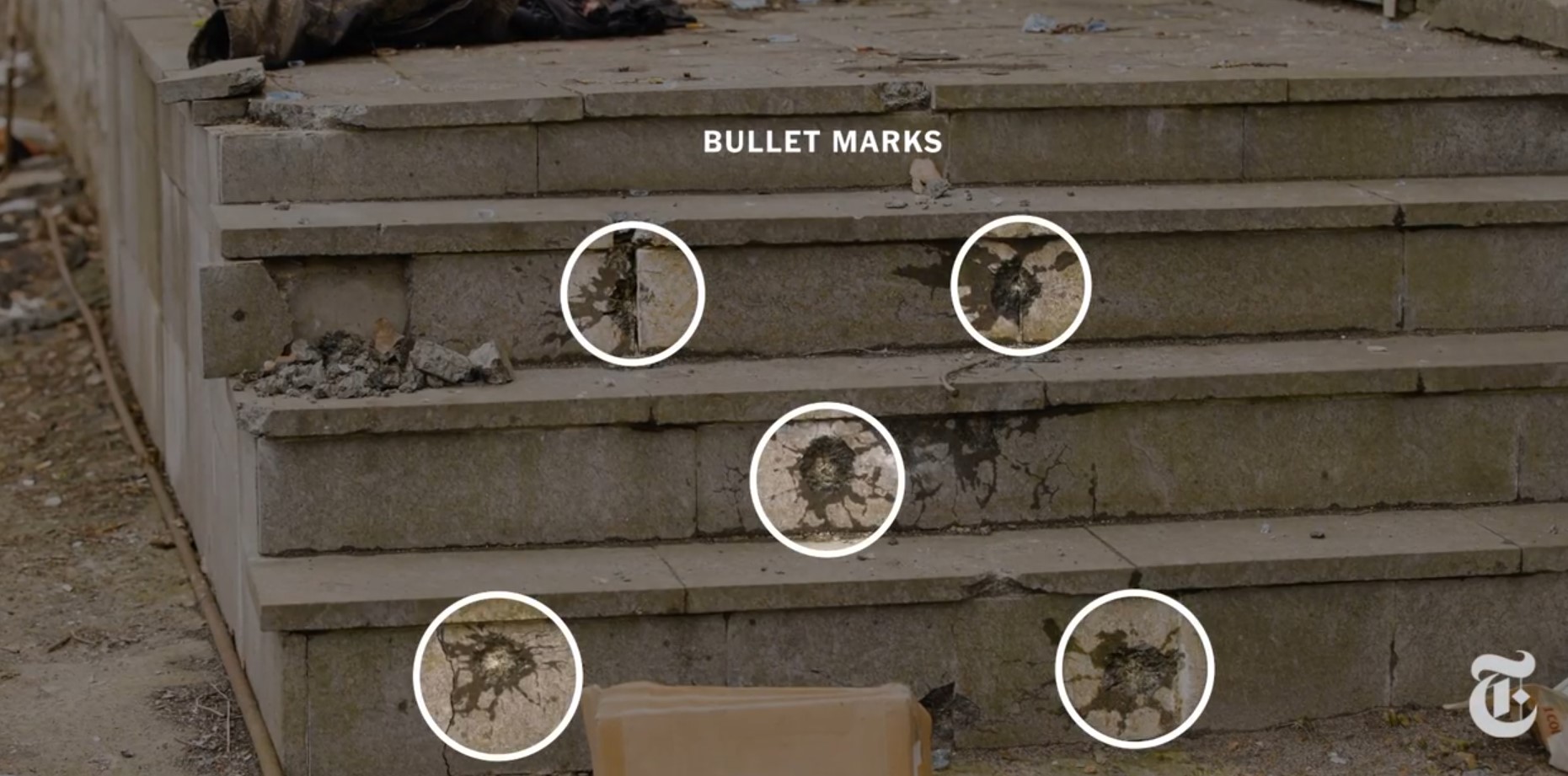
Other evidence left behind by the Russians points to two specific paratrooper units that may have occupied the building. The packing slips for crates of weapons and ammunition listed Units 32515 and 74268, corresponding to the 104th and 234th Airborne Assault Regiments.

Investigators with the Security Service of Ukraine also provided journalists with images of a patch found inside the building with the emblem of the 104th Regiment and a list of Russian soldiers who were pulled out of the building. By searching Russian websites on social media and other databases for each soldier, journalists found that at least five of those soldiers had apparent links to the 104th Regiment. Others posted images of them holding paratrooper flags or wearing paratrooper uniforms. Some listed their location as Pskov, the city that is the headquarters for both the 104th and 234th regiments.
The execution of captured Ukrainians and a homeowner in Bucha “is the kind of incident that could become a strong case of war crimes prosecution,” said Stephen Rapp, a former U.S. ambassador-at-large for war crimes issues.
According to Mr. Rapp, the prisoners, having been disarmed and taken into custody by the Russians, were “out of combat” under the laws of war. According to the United Nations and the International Committee of the Red Cross, such laws mean that prisoners must be treated humanely and protected from mistreatment in all circumstances.
According to Mr. Rapp, in addition to soldiers who shot the men, their commanders could be charged if they knew about the killings and failed to act to prevent or conduct.
Chingiz Atantaev
One Russian serviceman, featured in the investigation, was identified. Most likely, this is 37-year-old Chingiz Atantaev.
Atantaev was born in Magadan but has lived in Pskov for many years. It is in this city where the 104th and 234th assault regiments, which, according to The New York Times, are involved in the Bucha massacre, are being deployed.
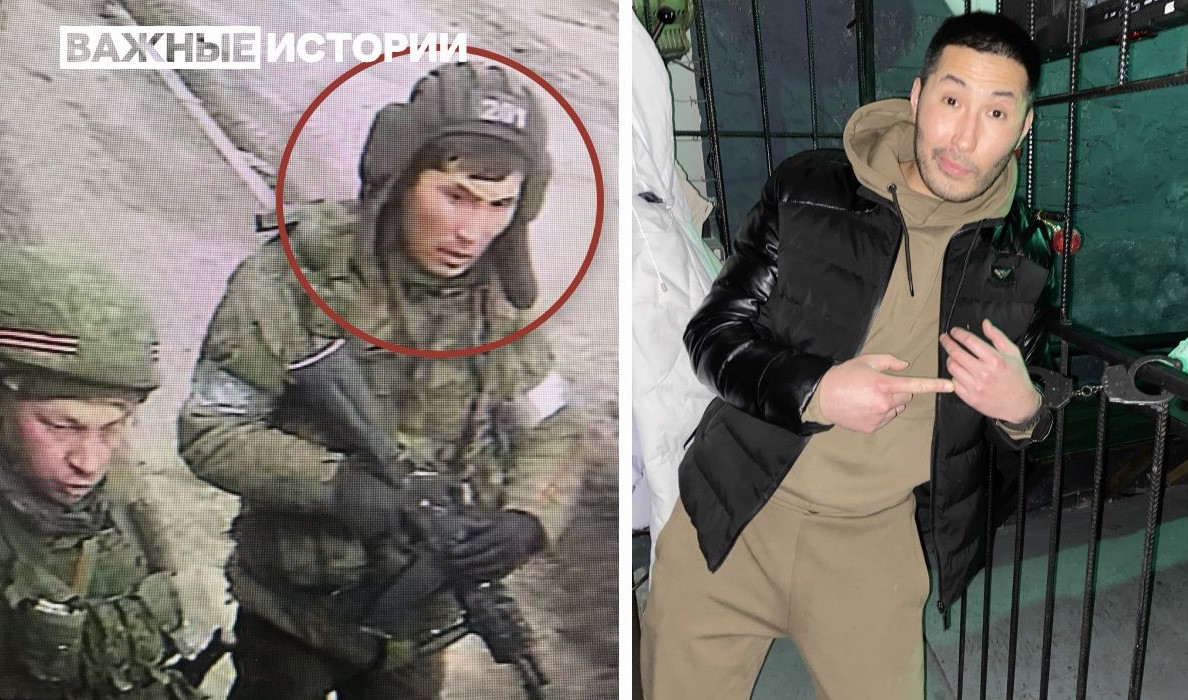
On social media, the soldier is subscribed to groups about the army, weapons, and martial arts. Moreover, in 2017, seeking to improve living conditions, he filed a lawsuit in the Pskov court with the Ministry of Defense “on the recognition of his wife’s minor daughter as a member of the family of a serviceman.”
The last time Atantaev visited his VKontakte page was on April 12. “Important Stories” contacted the soldier’s wife, Tatiana Chesnak, but she refused to share the contact information of her husband. The woman called The New York Times article a fake.
SUPPORT MILITARNYI
Even a single donation or a $1 subscription will help us contnue working and developing. Fund independent military media and have access to credible information.


 Роман Приходько
Роман Приходько 
 Віктор Шолудько
Віктор Шолудько 
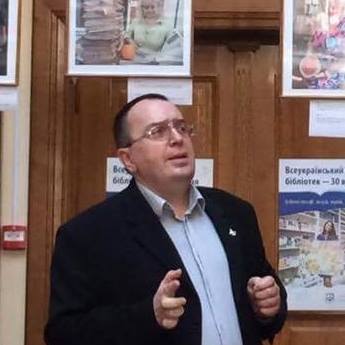 Андрій Харук
Андрій Харук 

 Андрій Тарасенко
Андрій Тарасенко 
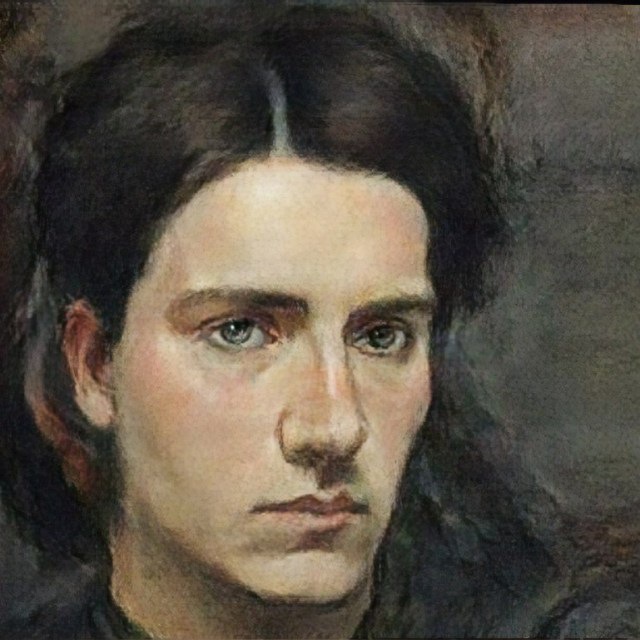 Yann
Yann 
 СПЖ "Водограй"
СПЖ "Водограй" 

 ГО "Військова школа "Боривітер"
ГО "Військова школа "Боривітер" 

 Катерина Шимкевич
Катерина Шимкевич 
 Олександр Солонько
Олександр Солонько 
 Андрій Риженко
Андрій Риженко 




